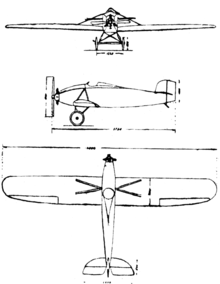| ANBO I | |
|---|---|
 | |
| General information | |
| Type | Prototype trainer aircraft |
| Manufacturer | Karo Aviacijos Tiekimo Skyrius |
| Designer | |
| Number built | 1 |
| History | |
| First flight | 14 July 1925 |
| Retired | 1935 |
| Developed into | ANBO II |
The ANBO I was a single-seat aircraft developed in Lithuania, proposed as a trainer for the Lithuanian Army. It was a low-wing, braced monoplane of conventional tailwheel configuration. The fuselage structure was of fabric-covered welded steel tube, The wing had a wooden, two-spar structure and was fabric covered but the fuselage, also fabric covered, had a welded steel tube structure. [1]
Contents
The first flight took place in 1925. Ten years later the aircraft was sold to the Lithuanian Aviation Museum in Kaunas where it is exhibited today. [2] [3]

